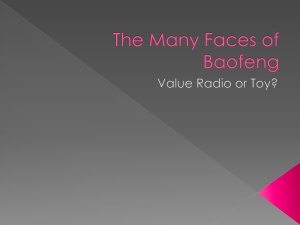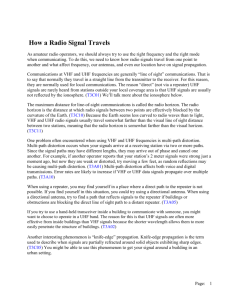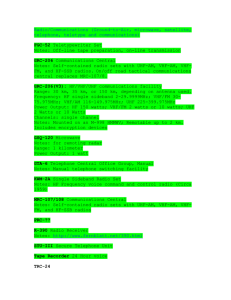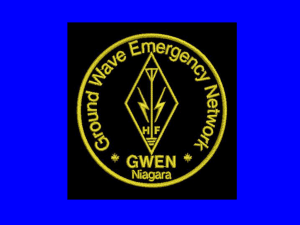linked
advertisement
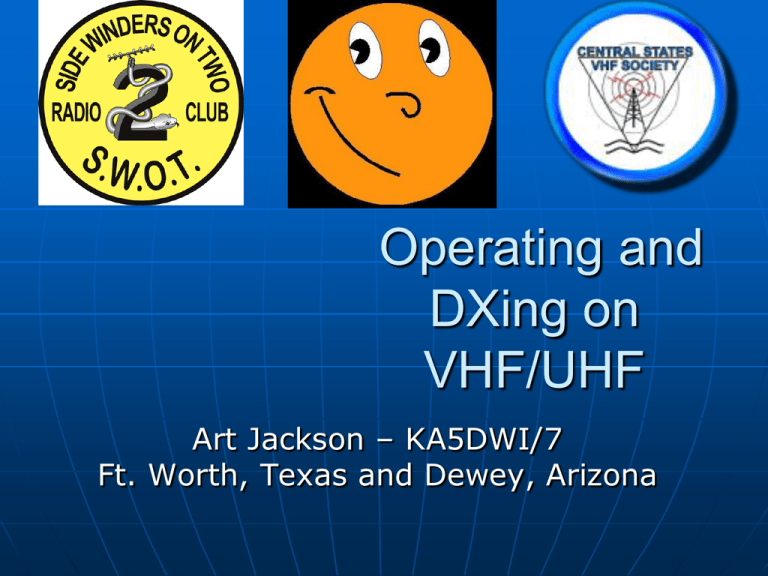
Operating and DXing on VHF/UHF Art Jackson – KA5DWI/7 Ft. Worth, Texas and Dewey, Arizona VHF/UHF Operating Going Beyond the Line of Sight The Time is Right. Interested in taking on the challenges of Weak Signal operation? Solar Cycle 24 is now declining. Upper HF band DX opportunities will become far and few between in the fall and winter. Ham equipment manufacturers have developed full coverage HF to VHF/UHF transceivers. Many used All-Mode rigs for VHF/UHF are available. Background of the Weak-Signal Operator (SSB Phone, CW and Digital) Tends to back into this part of the Ham radio hobby by pure accident Interest in Satellites Hearing DX on the local repeater 6/2/.70 Meter SSB or Satellite operation during Field Day Telecommunications & military background One VHF/UHF DX opening You are Team oriented, not Individual. My Background CB enthusiast – KBA5229 TV/FM, VHF/UHF DXer Ham since 1979 Operated 2 & 6 Meter station Field Day 1981 Interested in Satellites – Worked Mode A (2M up–10M down) Radio Sputnik 5-8 and AMSAT-OSCAR 09 in April 1982. During a 2M SSB Net someone reported hearing DX on a 2M local repeater. Worked first 2 Meter Es opening, hooked. Built a 4-element Quad for 6 Meters to pass the time. June 1987 bought a Drake TR6 just before the “greatest Es opening of all time”. My Background 2 Meter VUCC #237 6 Meter VUCC #295 April ’88 From Texas EM12 2 Meters: 43 States, 202 Grid Squares 6 Meters: 49 States, 530+ Grid Squares, 62 DXCC 70 CM: 11 States 47 Grid Squares Only 1 2M Grid was on Digital, all others predominately SSB and a few CW (6M). First day AMSAT-OSCAR 13 ½ of the 2-Meter N. American Continental DX Record for “Overland” Tropo. All done with single Yagis, 1 Quad, Low-loss RG8 or RG8X and 10-170 watts. Will everyone enjoy VHF/UHF SSB/ CW/ Digital? What kind of operator gets the most. VHF/UHF weak-signal is not for everyone. If you want instant gratification…. No Consider this as a secondary activity. If you expect activity like 20 Meters at the peak of the sunspot cycle… No You like studying propagation, to be at the right place at the right time… Yes Enjoy unique and special events, YOUR CALL IN LIGHTS…Yes The weak-signal specialist with limited resources must develop a general knowledge of physics, meteorology and astronomy in order to produce good results. The serious enthusiast can create their own opportunities with a top-notch Big-Gun station. You can do a lot with a little. Don’t accept negative comments. Operating – None Official SSB Call frequencies, DX-50.110, 50.125, 144.200, 432.100 MHz CW below 50.100 MHz and near 2M and 70CM SSB call frequencies. EME (Non CW) 144.100 – 144.125 MHz Meteor Scatter WSJT 50.265, 144.140 PSK31 50.290, 144.150 & 432.150 MHz General SSB Operating 50.125-.200+, 144.175 – 144.270, 432.100-.150 MHz Nets 50.150 – 50.200, 144.210–.260, 432.150-.200 MHz Beacons 50.050-.080, 144.275–.290 MHz Popular Rigs Used/Older Rigs are Available Peripherals Feed-lines Low-Loss RG-8 such as LMR400, Belden 9913, RG-214 for short runs (< 100 ft.). The higher the frequency the higher the loss. Large runs – Heliax and Hardlines Receive Preamps A power amplifier. Antennas - Simple Horizontallypolarized antennas are advised. Squalo or Halo Stacked arrays provide gain Best for mobile/portable operations Best Antennas The Yagi or Quad(gi) Gain is everything Some is better than none. Some openings can be hurt by too much. Most openings are enhanced by more gain. The serious DX operator must have a high gained Yagi(s) to have good results. The VHF/UHF DX Holy Grail The Quest for “VUCC” VUCC – VHF/UHF Century Club Moderate achievement with moderate effort 2-Meter VUCC #237 From Texas EM12 VUCC – VHF/UHF Century Club Moderate achievement with moderate effort 6 Meter VUCC #295 also from EM12 VUCC – VHF/UHF Century Club Moderate achievement with moderate effort 2015 First Year 6-Meters from DM34 Aurora K4QI (SK) NC in TX Aurora is a special propagation mode that is a result of the severe solar storms that are created by the Sun. During the entire Solar Cycle, sunspot regions form near adjacent Coronal Holes that often produce solar flares. Most of them are weak and are not pointed directly at the Earth. Every now and then, a major region facing the Earth produces a powerful flare. X-Class flares. The most powerful ones kill HF propagation. It is not the flare that produces Aurora, but it is the Coronal Mass Ejection (CME) that follows it that will create the magnetic disturbance one to two days later. The CME creates the strong Aurora Borealis that reflects 2 Meter signals. The stronger the magnetic disturbance, the further south it works. Aurora Typically, only the northern most states experience it on a regular basis. The southern states do experience it around once every 2 to 3 years to once a year during solar cycle peaks. A good skill of CW is needed for Aurora. SSB contacts occur, but are rare overall. QSOs are the result of backscatter. Yagis are pointed NW to NE and signals sound raspy with a buzzing sound. Digital modes are ineffective. It requires high gain Yagi antennas with reasonable power (150 watts+), but has been completed with low power and low gained antennas. Florida, South Texas and Central California worked Aurora over 10 years ago. Aurora – Internet Places to Watch Meteor Scatter 2M K9MRI Indiana EN70 during Leonids Storm Meteor Scatter was once considered a propagation mode to be used only during major annual meteor showers. Usually once or twice in a lifetime does a Meteor Storm (as in November 2001 and 2002) provide one a continuous 2-Meter DX event. Generally it required a pre-established schedule using timed transmissions between Ham radio operators. Only at the meteor shower’s peak, at a time period for the optimum direction for scatter, plus a lot of luck, did a non-coordinated CW or SSB contact work. Known as a random QSO. Meteor Scatter FSK441 MS with Thunderstorms The digital modes developed by K1JT’s WSJT changed it all. The WSJT mode known as FSK441 started the completing of random QSOs on 2 Meters. Scheduled QSOs are now being completed with ease during nonMeteor shower times. In the past few years, several Hams have accumulated over 40 states and nearly 300 Grid Squares using the WSJT FSK441 digital mode. Earth-Moon-Earth (EME) On-the-air From the Rig Due to the shear difficulty and distance that the signal travels, it requires the best equipment and antennas. UHF a definite size advantage. With a combination of several first-class stations and the development of the PC Interfaced and Soundcard digital modes, more simple set up stations are now completing their first QSOs on EME. WSJT is several digital modes developed by Nobel Prize winner Joe Taylor, K1JT. WSJT stands for “Weak Signal by K1JT”. Earlier versions were developed into a mode called JT65. It is the standard for EME work Many of the better equipped stations still use CW, and on very rare occasions SSB on EME. Overall, if you intend to regularly and successfully try EME, expect to make a serious financial commitment to equipment and construction of an antenna array. WSJT Modes PINGJOCKEY CENTRAL http://www.pingjockey.net/cgibin/pingtalk/ The primary digital mode used for Meteor Scatter is FSK441 Many can easily complete random MS QSOs on 6 & 2 Meters . JTMS was also developed for Meteor Scatter. JT6M and ISCAT has been used for 6 Meter Ionospheric Scatter. JT6M has been used for 6 Meter Meteor Scatter. JT65 and JT4 is used for EME QSOs. Most of these modes have sub-versions (A, B, C, D …G) Forgot, WSPR for propagation reporting. Pop Quiz at end of the presentation. Ionospheric and Atmospheric conditions. Sporadic Es Tropospheric Ducting (Tropo) F2 and TEP Sporadic Es 6M JL8GFB 2M K5UGM (SK) TX & KD4ESV FL c/o WA5IYX Sporadic Es are commonly referred to as “Short Skip”. Those who have operated 10-Meters or 11Meters (CB) often make DX QSOs by using this propagation mode. Soon after the Spring Equinox, the Maximum Usable Frequency (MUF) for the E-layer of the ionosphere easily reaches 28 then 50 MHz. On a few occasions, a docile and quiet 2-Meter band can become a beehive of DX activity. The old saying that “you can work them with 5 watts and a wet noodle” is not that farfetched. This mode of DX primarily occurs from the last week of April to the last week of August. A second season occurs from late November to late January, but is limited in occurrence and is extremely rare if it reaches a 144MHz MUF. 6M CT1HZE into Texas c/o WA5IYX Sporadic Es 2M K4MM FL Mid-Spring to mid-Summer season is when to concentrate on working Es. Prime season is June 1 – July 15 +/Using other tools, the Internet links, and software can prepare you for the opening. Most times Es propagation occurs first on lower frequencies (10 Meters), then intensifies to 6 Meters. More Es Tools DXMaps, N3TUQ, LiveMuf, SEProp Sporadic Es Monitoring analog/digital TV channels 2 thru 7, better yet the FM Broadcast band, and the Aircraft band will help one know where the optimum direction of the opening will occur. Most times a positive identification of a FM Broadcast station will be the best direction to an eventual 2-Meter opening. If you hear the DX on your favorite 2-Meter repeater, you have been missing the opening for quite some time!! 2M K9HUQ EL86 CQs Sporadic Es 6M HH7PV c/o WA5IYX Experienced Weak Signal enthusiasts listen for the increased noise levels associated with the band opening. Openings can vary in strength and length of time. It can be like Meteor Scatter, or can close and open continuously for many hours. Sometimes it has been open for a couple of days. When intense, many QSOs occur with low power and simple antennas. Still, the high powered and sophisticated arrayed stations will have the greater results. Once every ten to eleven years, in any one given area will experience a “Super” opening. In 1987, Oklahoma & Texas had a 2-Meter E opening simultaneously to both the East and West Coasts. A few 2Meter QSOs were completed between the coasts (doublehop). 6 Meters was open continuously over 27 hours. The Es MUF has made it to 222 MHz. Once you have worked 6 Meter multi-hop or 2 Meter Es, you will be hooked. There is not anything more exciting and exhilarating in all of Ham radio. Sporadic Es with FAI N6RMJ CA into TX Little is understood about FAI (Field Aligned Irregularities) It may be linked to Sporadic Es openings that are sparked by a solar disturbance. It tends to occur during an Es opening, but the antennas are not pointed towards each other. It can be 90 degrees off. Tropo The most active DX propagation mode is Tropo. Tropo is the result of specific weather events. It is also the easiest of the DX modes to predict. As long as you can decipher weather maps that show surface and upper air pressure patterns, you can have an edge in working DX by being ready. The same tools used in operating Sporadic Es are available for Tropo, plus a few additional ones. Tropo is caused by one simple weather phenomena, significant (area and in height) temperature inversions. Tropo can occur at any time and place, but tends to favor early Spring to Mid-Fall. Close proximity to large bodies of water (Gulf of Mexico, Pacific and Atlantic Ocean, and Great Lakes) help and influence it, but is not always required. Monitoring VHF & UHF TV, FM Broadcast, the Internet links, and seeing large patches of “false echoes” on the National Weather Service Radars easily confirm these conditions. Major Tropo events require a stable atmosphere. Stormy weather only create localized and short events. Tropo Tampa FL into DFW TX on a February afternoon. Major events are directly caused by the strong influence of an Upper-Air High Pressure system (15,00035,000 feet high) ridged over a surface High Pressure system. The area influenced occurs along the southwest, west and northwest areas of the surface and Upper Air High Pressure centers (the warm sides). A lack of upper air winds (indicating high pressure) helps cap the atmosphere. Temperate increases and the dew point decreases, resulting in a strong inversion to bend VHF and UHF signals. A hazy day, a warm foggy morning, heavy dew and a sudden increase in the daytime temperature from the day before are alerts to a possible Tropo condition. Types of Tropo Line-of-Sight Tropospheric Tropospheric Tropospheric (GW) Scatter (TrS) Enhancement (TrE) Ducting (TrD) Confirming Tropo Conditions KA2KQM & W4HP in late December NWS Radars do not remove false echoes September 6-7, 2003 The first Canadian based cold front followed by a strong surface high pressure system of the late summer/early fall moved through the eastern half of the United States. Once the front reached the Gulf of Mexico and the Atlantic Ocean, it stalled out just off shore. Meanwhile, a northward moving hurricane was situated between Bermuda and the U.S. East Coast. The hurricane had pushed the seasonal Bermuda High (the Upper Air one) well into the eastern half of the United States. The Event The high pressure’s western edge was located well into southern Texas to Nebraska and Iowa. Upper air winds in the eastern half of the U.S. were non-existent. For two evenings, successful SSB and CW QSOs were completed by many moderate to low powered Hams for distances just short of 1600 miles! A number of 30+ year old North American Tropo Continental DX records on 144 MHz and 222 MHz were broken. Most of the New England States completed QSOs with Texas, to Oklahoma, to Iowa on 2 Meter SSB. This was a once in a lifetime event. Still, many other long distance ones occur each year. Is There Tropo in Arizona? Yes - Enhancement Localized, but does exist Tropo loves valleys Conducted tests between myself and Ron, W7HD north of Tuscon – 165 miles. W7HD USB PSK31 @50 watts into a Vertical My stations 25 watts into a 4 element Yagi @ 20 feet. Connected multiple times. F2 & Trans-Equatorial (TEP) VK3OT c/o WA5IYX 6M AA7ML & WA5IYX KL7NO AK c/o WA5IYX Occurs during and after the peak of the Solar Cycle. Paths are very long. (TransContinental) TEP is exactly as defined, except it is the Geomagnetic equator F2 is limited to 6 Meters, TEP can occur on 6 or 2 Meters F2 & Trans-Equatorial (TEP) 6M NH7RO after a 2M Aurora opening F2 Backscatter on 6M c/o WA5IYX High solar activity with geomagnetic disturbances can create some excellent events Bad News… F2 was very rare this solar cycle. Bad News 2… The next solar cycle is predicted to be worse. We will have to depend on Es to F2 linkage. VHF/UHF/Weak Signal Radio Clubs Who promotes VHF and UHF DXing? There are many fine radio club promotes it exclusively. Side Winders on Two Radio Club, SWOT promotes 2-Meters. Six Meter International Radio Klub, SMIRK promotes 6-Meters. The Central States VHF Society is a worldwide organization that supports all aspects of Weak Signal operating. There is an annual conference the last weekend of July with Presentations and published papers. I refer to the conference as the world’s largest Nerd convention. All of these organizations have web homepages and social media outlets. Nets Day SUNDAY MONDAY Local Time Area Net Frequency Net Control Station 7:30P 9:00P SO. CALIFORNIA CENTRAL TEXAS BOZO NET (KB0ZO) ROADRUNNERS MICROWAVE 144.240 144.150 8:00P 8:00P NORTH GEORGIA SO CENTRAL OHIO OKLAHOMA NORTH GEORGIA K8TQK W5VHF - WEAK SIGNAL GROUP ROCKY MT, VHF + 144.210 144.252 144.190 W4TMV Tom K8TQK Glenn N5NET Jimmy 144.220 K0MLM 8:00P CO, WY, NM, KS, NE Several K5LLL Ron TUESDAY 9:00P SOUTHERN TEXAS DEEP SOUTH TEXAS SWOT 144.250 N5SSH Frank WEDNESDAY 8:00P 8:00P 8:00P TX, OK, LA & KS CENTRAL WISCONSIN NO. ARIZONA NORTH TEXAS SWOT 144.240 NET YAVAPAI 2-METER SSB 144.250 144.240 144.220 W5FKN Bob WB9YLH Mark WN7E Tom THURSDAY 8:00P 8:00P CA SO CTYS OK,AR,TX,KS,MO NORCAL SWOT 144.250 144.250 W6DWI Robin N5NET Jimmy W5SKS Stan W5VTM Larry SATURDAY 9:00P MEMPHIS TN MID SOUTH AREA 2M SSB GROUP 144.255 KD4NOQ David MON - SAT 8:00 A CO, WY, NM, KS, NE BEAM SPINNERS NET 144.200 WA7KYM Duane SWOTRC.NET
